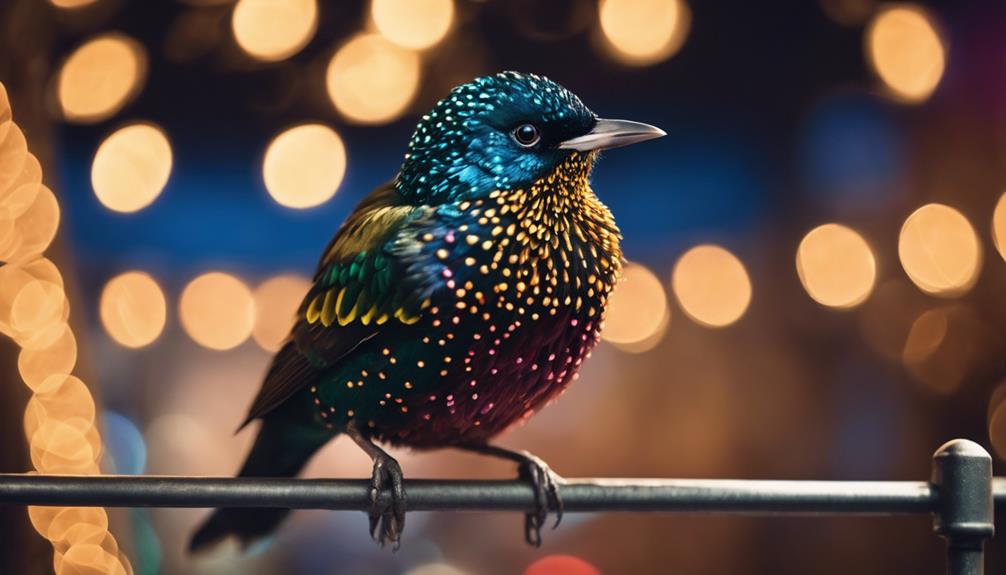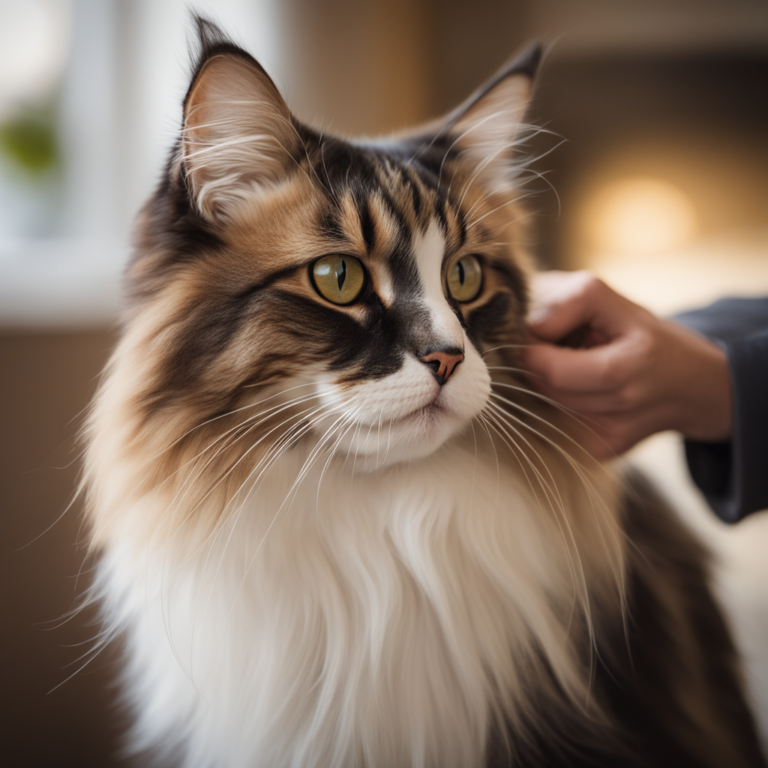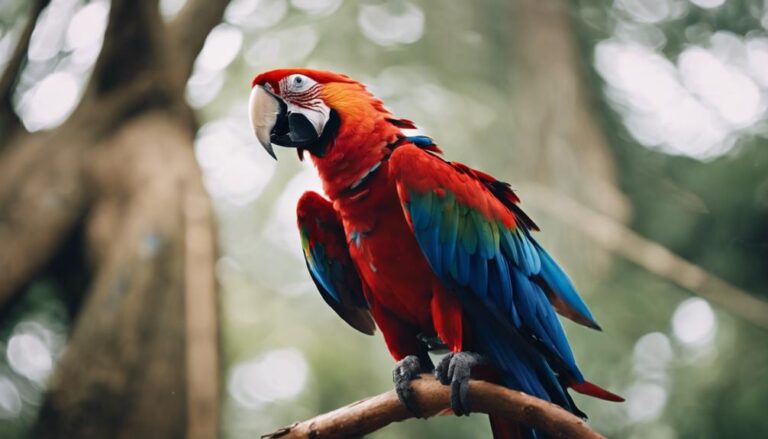Showy Starlings: Pet Birds As Show Animals

Pet Birds As Show Animals: Imagine owning a stunning Superb Starling, its iridescent blue and orange plumage catching the light as it flits around your living room. But have you ever considered taking your pet bird beyond just a household companion? Showy starlings have been making waves in the world of competitive bird shows with their beauty and intelligence. As you explore the possibilities of showcasing your starling, you’ll uncover a world where feathers and finesse combine to create a mesmerizing spectacle that captivates both judges and audiences alike.
History of Showy Starlings
The evolution of breeding practices for showy starlings can be traced back to the early 19th century when enthusiasts began selectively pairing birds for specific aesthetic traits. This marked the beginning of a deliberate process that led to various evolutionary adaptations in these birds. Through careful selection based on traits like vibrant plumage and distinct vocalizations, breeders influenced the genetic makeup of showy starlings over generations. This process resulted in the development of unique physical characteristics that distinguish showy starlings from their wild counterparts.
The cultural significance of showy starlings cannot be understated. These birds have long been revered for their beauty and elegance, making them sought-after pets and show animals. In many cultures, owning a showy starling was a symbol of wealth and status, leading to the proliferation of breeding programs aimed at producing the most captivating specimens. Showy starlings became a source of pride for their owners, who would showcase them at exhibitions and competitions to demonstrate their breeding skills and the beauty of their birds.
Over time, the breeding practices surrounding showy starlings have become more refined, with breeders continuously striving to enhance the aesthetic appeal of these birds. Through the careful selection of breeding pairs and the incorporation of scientific knowledge, enthusiasts have been able to further shape the evolutionary path of showy starlings, resulting in the diverse array of breeds and color variations seen today.
Unique Physical Characteristics
With meticulous breeding practices, showy starlings exhibit a remarkable array of unique physical characteristics that set them apart from their wild counterparts. In terms of feather coloration, showy starlings boast vibrant hues such as iridescent blues, purples, and greens that shimmer in the light. These striking colors are a result of selective breeding over generations to enhance the visual appeal of these birds for show purposes.
Beyond their colorful plumage, showy starlings also display distinct behavior patterns that distinguish them from their wild counterparts. Through careful breeding, showy starlings have developed more docile and sociable temperaments, making them easier to handle and train for exhibitions. This contrast in behavior is a testament to the deliberate efforts of breeders to enhance specific traits in these birds.
In addition to their feather coloration and behavior patterns, showy starlings have undergone physical adaptations that contribute to their showy appearance. These adaptations include features like sleeker body shapes, longer tails, and more symmetrical proportions, all of which enhance the aesthetic appeal of these birds in a show setting.
Furthermore, showy starlings are known for their complex vocalization techniques, which have been refined through selective breeding. These birds exhibit a wide range of melodic calls and songs, showcasing their vocal prowess and adding to their allure as show animals. Through a combination of selective breeding and dedicated care, showy starlings have evolved to possess a unique set of physical characteristics that make them captivating additions to the world of avian exhibitions.
Intelligence and Trainability
Intelligence and trainability play crucial roles in shaping the capabilities of showy starlings as exceptional performers in avian exhibitions. These birds possess remarkable cognitive abilities that, when coupled with effective training techniques, make them stand out in shows. Here are five key points to consider:
- Problem-Solving Skills: Showy starlings demonstrate impressive problem-solving abilities, allowing them to quickly learn and adapt to new tricks and tasks during training sessions.
- Memory Retention: Their cognitive prowess enables them to retain a wide range of cues and commands, making them adept at performing complex routines with ease.
- Social Learning: Showy starlings are highly social birds, benefiting from observing and learning from other birds, which accelerates their training progress.
- Positive Reinforcement: Training techniques that utilize positive reinforcement, such as rewards like treats or praise, are particularly effective in motivating showy starlings to excel in their performances.
- Attention to Detail: These birds exhibit keen attention to detail, allowing them to pick up on subtle cues from their trainers and respond accordingly, showcasing their high level of trainability.
Understanding the intricate balance between their intelligence, trainability, and the application of appropriate training techniques is essential in unlocking the full potential of showy starlings as captivating show animals.
Social Nature and Bonding
When considering the social nature and bonding of showy starlings, it’s crucial to understand that these birds form strong bonds through regular interaction with their owners. Companionship plays a vital role in the well-being of starlings, as they thrive on social connections and the presence of a trusted human companion. Observing the social behaviors of starlings can offer insights into their intricate communication patterns and the dynamics of their relationships within a domestic setting.
Bonding Through Interaction
Interacting regularly with your showy starling is essential for fostering a strong bond and understanding of their social nature. Engaging in various bonding activities and interactions with your pet bird can significantly benefit your relationship. Here are some key ways to bond through interaction:
- Daily Conversations: Chatting with your starling daily helps them feel connected to you.
- Training Sessions: Teaching your starling tricks enhances communication and trust between you.
- Feather Grooming: Gently preening your bird’s feathers mimics social behavior seen in the wild.
- Shared Playtime: Playing games together stimulates their intellect and strengthens your bond.
- Meal Sharing: Offering treats while eating can create a positive association and deepen your connection.
Importance of Companionship
Companionship plays a crucial role in fostering the social nature and bonding of showy starlings. These birds thrive on interaction with their fellow companions, deriving numerous benefits from these relationships. Through companionship, starlings experience emotional support and form friendships that are essential for their well-being. Bonding with other starlings helps in the development of their social skills, communication abilities, and overall mental health. The presence of companions can reduce stress levels and enhance the quality of life for showy starlings. Additionally, engaging in social interactions creates a sense of belonging and security within their environment. Thus, companionship is not only important for the social nature of these birds but also contributes significantly to their overall happiness and welfare.
Social Behaviors in Starlings
The social dynamics of showy starlings revolve around their inherent need for connection and bonding with fellow avian companions. These birds exhibit intricate communication patterns to maintain social cohesion and hierarchy within their flock. Observing their social dynamics can be fascinating, as they display various behaviors such as grooming each other, engaging in synchronized movements, and vocalizing to convey different messages. Breeding behaviors in starlings are also noteworthy, with pairs forming strong bonds through elaborate courtship displays and building intricate nests together. The way starlings work together to construct their nests showcases their cooperative nature and unity within the group. Witnessing these social interactions provides insight into the complex and harmonious world of showy starlings.
- Grooming each other
- Synchronized movements
- Vocalizing messages
- Elaborate courtship displays
- Building intricate nests together
Vocal Mimicry Abilities
Starlings possess remarkable vocal mimicry abilities, including the talent to mimic human speech with surprising accuracy. These birds can produce a wide variety of sounds, from ringing phones to barking dogs, showcasing their impressive vocal repertoire. Additionally, starlings have been observed learning new vocalizations throughout their lives, making them fascinating creatures to study and interact with.
Mimicking Human Speech
Known for their remarkable vocal mimicry abilities, showy starlings can imitate human speech with astonishing accuracy and clarity. These intelligent birds have captivated many with their ability to replicate various sounds, including human words and phrases. When engaging in speech therapy or interacting with humans, showy starlings showcase their impressive mimicry skills, enhancing communication and bonding opportunities. Here are five intriguing aspects of their vocal mimicry abilities:
- Showy starlings effortlessly mimic tones and accents, adding a unique touch to their vocal repertoire.
- Their exceptional clarity and enunciation make them stand out as masters of mimicking human speech.
- These birds can accurately replicate sounds from their environment, showcasing their adaptability.
- Showy starlings often surprise listeners with their ability to mimic complex phrases and sentences.
- Their vocal mimicry skills contribute to their charm and popularity as pet birds.
Variety of Sounds
With remarkable versatility, showy starlings astound listeners by effortlessly reproducing a diverse array of sounds, showcasing their extraordinary vocal mimicry abilities. These birds possess a wide vocalization variety, allowing them to imitate not only human speech but also various environmental sounds such as car alarms, doorbells, and musical tunes. To enhance their sound repertoire, training techniques play a crucial role. Behavior modification through positive reinforcement is often used to encourage starlings to mimic specific sounds effectively. By rewarding the birds when they produce desired vocalizations, trainers can shape and refine their mimicry skills. The ability of showy starlings to mimic an extensive range of sounds makes them captivating and entertaining pets, delighting audiences with their impressive vocal performances.
Learning New Vocalizations
Mastering new vocalizations is a complex process that showcases the remarkable vocal mimicry abilities of showy starlings. These intelligent birds excel at vocalization training, using behavioral cues to learn and imitate sounds. When learning new vocalizations, they pay close attention to communication cues from their surroundings, picking up on subtle nuances in tone and pitch. Showy starlings exhibit impressive mimicry techniques, effortlessly mimicking a wide range of sounds from their environment. They often incorporate these new vocalizations into their repertoire, adding depth and complexity to their vocal performances. In their quest to learn and master new sounds, showy starlings demonstrate their adaptability and versatility in vocal communication.
Showy Starlings in Competitive Circuits
In competitive circuits, Showy Starlings are often judged based on their plumage quality, vocal abilities, and overall presentation. Showy starlings in fashion and grooming play a crucial role in these competitive show starling circuits. Judges look for starlings with vibrant, glossy feathers that exhibit iridescence under light, indicating good health and genetic quality. The grooming aspect involves meticulous attention to detail, ensuring the feathers are clean, well-kept, and properly preened. Breeders and owners often use specialized products to enhance the sheen and color of the plumage, giving their starlings a competitive edge.
Competitive show starling circuits are dynamic environments where trends constantly evolve. Judges are keen on identifying starlings that not only meet the traditional standards but also showcase unique characteristics that set them apart from the competition. For instance, starlings with exceptional mimicry skills or the ability to perform complex vocalizations may garner extra attention. Breeders and trainers study these trends closely, working to enhance their starlings’ abilities and capitalize on the latest preferences within the show circuit.
Grooming and Care for Shows
To excel in show grooming, you must focus on the basics: feather conditioning, beak maintenance, and nail trimming. A balanced diet regimen is crucial for their overall health and appearance, emphasizing a mix of seeds, fruits, and vegetables. Regular health check routines, including weight monitoring and beak health assessments, are essential to ensure your starling is in prime condition for shows.
Show Grooming Basics
When preparing your show starling for competition, meticulous grooming and care are essential to showcase the bird at its best. Here are some key grooming basics to help you present your starling in top condition:
- Feather care: Regularly inspect and clean the feathers to ensure they are free from debris or damage.
- Beak trimming: Trim the beak carefully to maintain a proper shape and length for the show.
- Nail clipping: Keep the nails trimmed to prevent any discomfort or injuries during handling.
- Bath and blow-dry: Provide regular baths to keep the feathers clean and shiny, followed by a gentle blow-dry to ensure they look their best.
- Tail feather maintenance: Pay special attention to the tail feathers, keeping them neatly trimmed and aligned for a polished look on stage.
Ideal Diet Regimen
Maintaining an ideal diet regimen is crucial for grooming and caring for show starlings to ensure they are in optimal condition for competition. When preparing your starling for shows, consider incorporating nutritional supplements into their diet. These supplements can provide essential vitamins and minerals that may be lacking in their regular food. It’s important to establish a consistent feeding schedule to regulate their intake and ensure they are getting the necessary nutrients.
A balanced diet rich in fruits, vegetables, seeds, and high-quality pellets is recommended for show starlings. Monitoring their food intake and adjusting their diet as needed will help keep them healthy and vibrant for the spotlight. Remember, a well-fed starling is a happy starling ready to shine at competitions.
Health Check Routines
Regular health check routines are essential for ensuring your show starlings are in prime condition for competitions. To maintain their health and appearance, follow these important steps:
- Routine Check-ups: Schedule regular visits to an avian veterinarian for thorough examinations.
- Preventive Care: Stay up to date on vaccinations and parasite control to prevent illnesses.
- Nutritional Needs: Provide a balanced diet rich in essential nutrients to support their overall health.
- Exercise Requirements: Allow your starlings plenty of space to fly and exercise daily to keep them physically fit.
- Grooming: Trim their nails and beaks as needed, and regularly groom their feathers to keep them looking their best for shows.
Diet and Nutrition Requirements
For optimal health and vitality, showy starlings require a well-balanced diet rich in essential nutrients and vitamins. These birds have specific feeding habits that need to be met for their overall well-being. Showy starlings should be fed a mix of seeds, pellets, fresh fruits, and vegetables to ensure they receive the necessary nutrients. It’s crucial to maintain a nutritional balance in their diet to support their feather quality, immune system, and overall health.
Special treats can be given occasionally to provide enrichment and variety in their diet. However, these treats should not exceed 10% of their total daily food intake to prevent nutritional imbalances. When offering treats, opt for healthy options like small pieces of berries, leafy greens, or mealworms.
In some cases, dietary supplements may be necessary to address specific deficiencies or health conditions. Consult with an avian veterinarian before introducing any supplements to your showy starling’s diet to ensure they are appropriate and safe. Common supplements include those rich in calcium, vitamin D, and omega-3 fatty acids.
Remember to provide fresh water daily and monitor your starling’s food intake to ensure they are eating a balanced diet. By paying close attention to their nutritional needs and offering a diverse range of foods, you can help your showy starlings thrive and maintain their health for their role as show animals.
Housing and Environment Setup
To ensure the well-being and comfort of your showy starlings, provide a spacious and enriching housing environment that mimics their natural habitat. When setting up the perfect home for your starlings, consider the following:
- Cage Decorations: Include branches, perches, and swings to encourage natural behaviors like climbing and swinging. These elements also provide mental stimulation for your birds.
- Temperature Control: Maintain a comfortable temperature range between 65-75°F (18-24°C) to keep your starlings healthy and stress-free.
- Nesting Materials: Offer natural materials such as straw, hay, or untreated wood shavings for nest-building activities. This will satisfy their natural instincts and promote nesting behaviors.
- Natural Light Exposure: Place the cage in an area with access to natural light. Sunlight is essential for your starlings’ vitamin D production and overall well-being.
- Space Consideration: Ensure the cage is large enough to allow for ample movement. Starlings are active birds that require space to fly and exercise, so provide a spacious environment.
Enrichment Activities for Stimulation
Engage your showy starlings in a variety of stimulating activities to promote their mental and physical well-being. Enrichment toys play a crucial role in keeping your starlings active and engaged. Consider providing toys that encourage foraging behaviors, such as puzzle feeders where your birds need to work to access their food. This not only stimulates their minds but also mimics their natural instinct to search for food in the wild. Interactive games like teaching your starlings to solve puzzles can provide mental stimulation and prevent boredom. These games can range from simple tasks like unlocking a treat from a box to more complex activities that challenge their problem-solving skills.
Rotate the enrichment toys and games regularly to keep your starlings interested and prevent them from getting bored. Introducing new toys can spark curiosity and provide fresh challenges for your birds. Additionally, consider incorporating natural elements into their environment, such as branches for perching and chewing, to stimulate their senses and encourage natural behaviors. By offering a variety of enrichment activities, you can help ensure that your showy starlings lead happy, healthy lives filled with mental stimulation and physical exercise.
Health and Veterinary Care Tips
To ensure the health of your showy starlings, it is crucial to maintain a balanced diet high in essential nutrients like vitamins and minerals. Regular veterinary check-ups are imperative for monitoring the overall health and well-being of your pet birds. By providing proper nutrition and routine medical care, you can help your starlings thrive and shine in the show arena.
Diet and Nutrition
Proper diet and nutrition play a crucial role in maintaining the health and well-being of showy starlings kept as pet birds. To ensure your starling thrives, consider the following:
- Nutritional Balance: Offer a variety of seeds, pellets, fruits, and vegetables to meet their dietary needs.
- Feeding Schedules: Establish a consistent feeding routine to prevent overeating or undernourishment.
- Dietary Supplements: Consult with an avian veterinarian to determine if your starling requires any specific supplements for optimal health.
- Hydration Needs: Provide fresh water daily to keep your starling hydrated, especially in warmer climates.
- Monitor Food Intake: Keep an eye on how much your starling consumes to prevent obesity or malnutrition.
Following these guidelines will help ensure your showy starling remains healthy and vibrant.
Regular Vet Check-ups
How frequently should you schedule vet check-ups to ensure the health and well-being of your showy starling? Regular vet check-ups are crucial for maintaining the health of your bird. It is recommended to schedule a check-up at least once a year for a healthy adult showy starling. However, if your bird has any underlying health conditions or is a senior bird, more frequent visits may be necessary.
Preventative care is essential in identifying any potential health issues early on. During these check-ups, the vet will conduct a thorough physical examination, check your bird’s weight, assess its overall condition, and address any concerns you may have. By staying proactive with regular vet visits, you can help ensure your showy starling remains healthy and happy for years to come.
Choosing the Right Show Starling
When selecting a show starling, consider the bird’s physical characteristics, behavior, and temperament to ensure it meets the requirements of the show standards. Show starlings are judged based on specific criteria, so choosing the right bird is crucial for success in competitions. Here are some key factors to consider:
- Coloration: Opt for starlings with vibrant and well-defined plumage colors as they tend to stand out more during shows.
- Size and Shape: Look for starlings that conform to the standard size and shape expected in competitions, as deviations may lead to point deductions.
- Feathering: Select birds with smooth, glossy feathers that are in prime condition, as this reflects good health and care.
- Behavior: Choose starlings that exhibit confidence, and alertness, and are comfortable with human interaction, as these traits can enhance their performance during shows.
- Temperament: Prioritize starlings that are calm, responsive to training, and can showcase their natural behaviors gracefully in front of an audience.
Handling and Show Preparation
To ensure your show starling is prepared for competitions, it is essential to focus on proper handling techniques and meticulous show preparation. Show bird handling plays a crucial role in ensuring your starling is comfortable and cooperative during competitions. When handling your bird, always approach it calmly and gently. Use positive reinforcement techniques such as offering treats to create a positive association with handling. Regular grooming is also important to keep your starling looking its best for shows. This includes trimming nails, cleaning feathers, and ensuring the beak is in good condition.
Show preparation involves more than just handling; training is a vital component. Training your starling to perform specific behaviors on command can greatly enhance its performance in competitions. Start training early and use rewards like treats or praise to reinforce desired behaviors. Practice regularly to ensure your starling is comfortable and confident with the routines required in shows. Additionally, acclimate your bird to the show environment by exposing it to different stimuli and practicing in settings similar to competition venues.
Show Performance Tips and Tricks
For optimal show performance with your starling, focus on implementing advanced training techniques and incorporating engaging enrichment activities to showcase your bird’s full potential. Utilize the following training techniques, performance secrets, and showmanship tips for maximizing your starling’s impact during performances:
- Target Training: Teach your starling to touch a target stick with its beak or feet. This helps in directing its movements during the show.
- Positive Reinforcement: Use a combination of treats, verbal praise, and toys as positive reinforcements during training sessions to encourage desired behaviors.
- Routine Practice: Establish a consistent training schedule to keep your starling’s skills sharp and ensure it is ready for the spotlight.
- Innovative Tricks: Teach your starling unique tricks like mimicry, flying through hoops, or solving puzzles to captivate the audience.
- Crowd Engagement: Incorporate interactive elements into your show, such as allowing the audience to participate in simple tricks or feeding your starling on stage to create a memorable experience for viewers.
Showy Starlings: Future Trends and Opportunities
As the demand for avian entertainment continues to evolve, the future of showy starlings presents exciting prospects for innovative performances and expanding opportunities in the pet bird industry. One of the emerging trends in the showy starling world is the use of advanced training techniques to enhance their natural behaviors and intelligence. Trainers are increasingly focusing on positive reinforcement methods, such as clicker training, to teach starlings complex tricks and routines, paving the way for more engaging and captivating performances.
Future opportunities for showy starlings also include the integration of technology into their acts. With the rise of augmented reality and virtual reality experiences, there is potential for incorporating these technologies into starling shows to create immersive and interactive performances for audiences. Imagine a show where audiences can wear AR glasses and see digital enhancements to the starlings’ aerial displays, making the experience even more mesmerizing.
Furthermore, there is a growing interest in environmental conservation and education, presenting an opportunity for showy starlings to become ambassadors for their wild counterparts. By showcasing the intelligence, beauty, and agility of starlings through performances that highlight conservation messages, these birds can help raise awareness about the importance of protecting their species and habitats. Embracing these future trends and opportunities will not only elevate the entertainment value of showy starlings but also contribute to the greater good of avian welfare and conservation efforts.
Pet Birds As Show Animals Frequently Asked Questions
Can Showy Starlings Be Taught to Perform Tricks Other Than Vocal Mimicry?
Yes, showy starlings can be taught various tricks beyond vocal mimicry through positive reinforcement training methods. While they have cognitive limitations, incorporating behavioral enrichment techniques can enhance their learning abilities and provide mental stimulation.
How Do Showy Starlings Handle Travel and Being in Unfamiliar Environments During Competitive Circuits?
When showy starlings travel to unfamiliar places for competitive circuits, they rely on your training techniques. Manage their stress by maintaining familiar routines, providing safe spaces, and using positive reinforcement. This helps them adjust and perform well.
Are There Specific Grooming Techniques or Products That Enhance a Showy Starling’s Appearance?
To enhance your showy starling’s appearance, focus on feather grooming with specialized products. Consider supplements for optimal feather health. Show training can improve presentation. Manage diet to ensure proper plumage and vibrant coloration, enhancing your bird’s show-ready look.
What Are Some Common Health Issues That Showy Starlings May Face, and How Can They Be Prevented or Treated?
To keep your showy starling healthy, provide a balanced diet, regular exercise, and a clean environment. Preventative care includes regular vet check-ups and monitoring for signs of common health issues like respiratory infections. Treatment options may involve medication or dietary adjustments.
Are There Any Regulations or Guidelines That Showy Starling Owners Must Follow When Participating in Competitive Shows?
When participating in competitive shows with showy starlings, it’s crucial to adhere to regulations and guidelines set forth to ensure showy starlings welfare. Familiarize yourself with competitive show rules to promote ethical treatment and care.
Conclusion
In conclusion, showy starlings make excellent pet birds for those interested in showcasing their intelligence, trainability, and social nature. Their unique physical characteristics and vocal mimicry abilities add to their appeal as show animals. By choosing the right starling, proper handling, and show preparation, owners can ensure a successful performance. As the popularity of showy starlings continues to grow, there are exciting future trends and opportunities for enthusiasts to explore this fascinating hobby.








